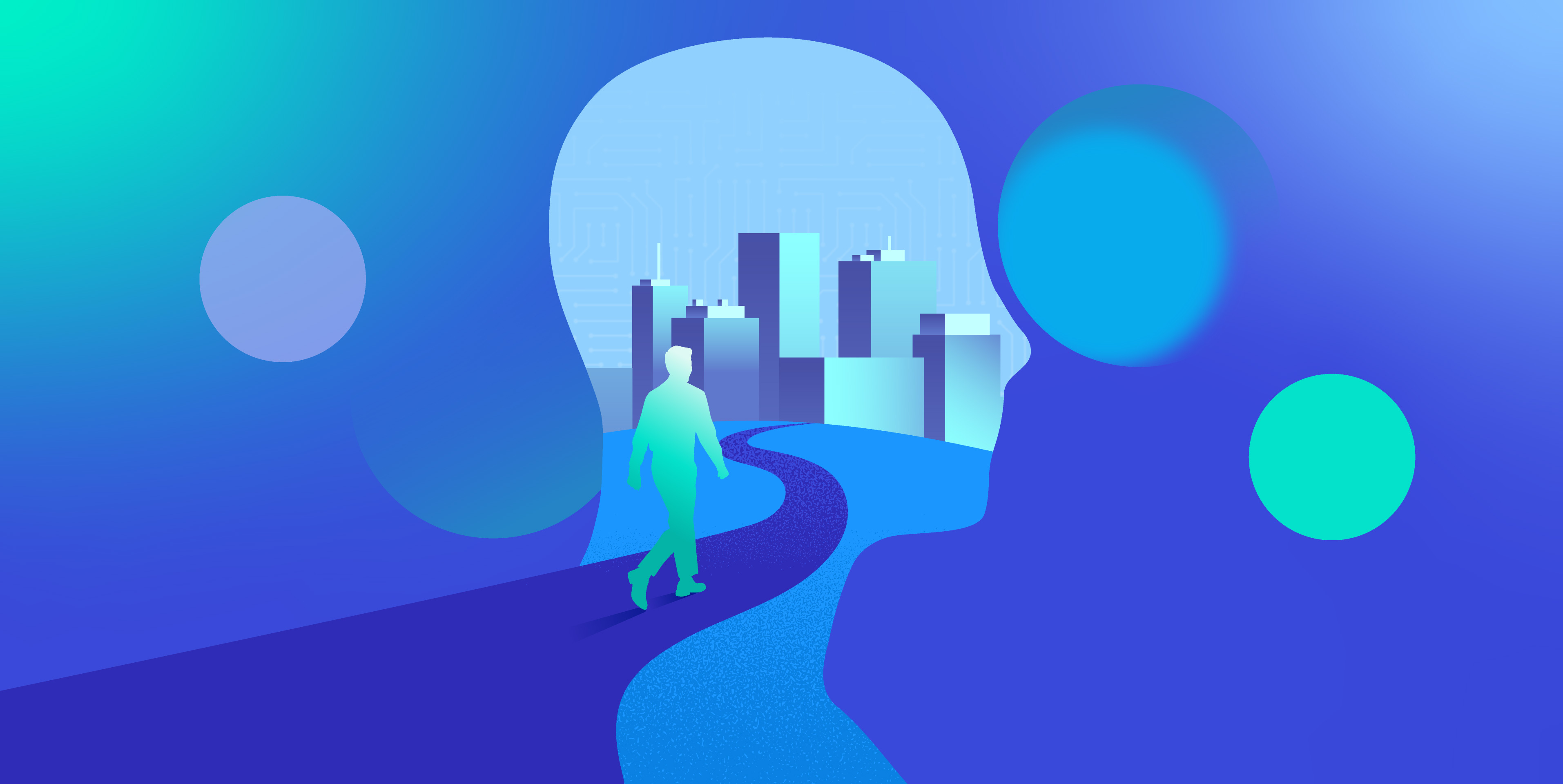
7 Key Elements of an Agentic Enterprise
Imagine a workplace where companies move with greater efficiency and speed by pairing humans with AI-powered agents. Where this partnership happens in the platforms that employees work in, like customer relationship management (CRM) or collaboration software. Where leaders rethink processes from the ground up, so that workforces can stretch and grow in ways only dreamed of in the past.
This is the agentic enterprise, a seamless ecosystem where human employees and artificial intelligence (AI) agents work side by side. “It’s an enterprise in which you rethink your whole business or organization to ask, ‘Where can agents help?’” said Jim Roth, president of customer success at Salesforce.
Think of the agentic enterprise as an organization where agents are embedded into every business process and workflow — not as side projects, but as the operating system of the enterprise. “It’s about moving from siloed tools and copilots to a unified platform where agents listen, reason, and act on behalf of the company and its employees,” said Bob Vanstraelen, executive vice president and CEO of EMEA North for Salesforce.
It’s also the next stage in the evolution of business.


What’s your agentic AI strategy?
Our playbook is your free guide to becoming an agentic enterprise. Learn about use cases, deployment, and AI skills, and download interactive worksheets for your team.


What does an agentic enterprise look like?
The agentic enterprise is about more than adopting new AI tools. It’s a fundamental rethinking of how work gets done, and the biggest shift in the workplace since the Industrial Revolution. Here are seven key elements that define an agentic enterprise.
1. Conversations become actions
In the past, conversations led to insights and recommendations, and based on that information, an employee took action. Now, you can choose to have an AI agent participate in a conversation and take the required action.
What does this look like in real life? Let’s say you sent a message to a sales rep about licenses you wanted to reallocate. The rep replied, “No problem, let’s find a time to talk.” You agreed on a time and date, left the messaging app, went to your calendar, scheduled a meeting, and sent an invite.
In an agentic enterprise, an agent handles all this. After you agree on a time, the agent automatically schedules the meeting. There’s no need to go to another app or take more steps. Your conversation becomes an action the agent completes.
This could also take place in interactions with your customers. A streaming service, for example, might notify a customer that their device is set to the wrong resolution. But rather than directing them to a web page that lists numerous steps to fix the problem, an agent might ask, “Want me to fix that for you?”
“It’s the ability for an agent to ask, ‘Would you like me to do that for you right now, so you don’t have to go do it yourself?’” said Joe Inzerillo, chief digital officer at Salesforce.
2. Agents are built into the flow of work
When employees switch between apps, portals, and browsers, it disrupts their work and concentration. But what if agents were present where humans already work, so employees could stay in one place — for example, in their CRM, or their data visualization or collaboration platform?
This is already happening at Salesforce, where Slack is the conversational interface for the agentic enterprise. Agentforce, the Salesforce platform for building and deploying agents, has more than 20 types of agents in Slack, and they’re available to 90% of the company’s employees. Among those agents is Slackbot, a new personalized AI companion for employees that will be available to customers at the beginning of 2026.
“The beauty of having agents built into the flow of work in Slack is that Slack is conversational,” said Connor Marsden, president of sales at Salesforce. “It allows the agent to participate in the conversation just like a human, and provide the right answers or relevancy.”
If, for example, your sales team was messaging about a new competitor, the sales coach agent in Slack might pull up research about the other company. It might also suggest how to best compete against it.
But there’s a more subtle advantage to having agents in the flow of work: It breaks down silos and reduces waste. “There’s a lot of wasteful activity that goes into retrieving the right answer or identifying the next best action,” said Vala Afshar, Salesforce’s chief digital evangelist, and co-author of “Autonomous: Why the Fittest Businesses Embrace AI-First Strategies and Digital Labor.”
When agents are present and can draw upon knowledge from across the company, they save time, energy, and money.
3. Companies are working with elastic workforces
Companies have always been limited in what they could achieve by the size of their workforce. “But now, you can extend your workforce with AI agents, and scale up or down, depending on the demand,” said Vanstraelen.
Consider the educational publisher Wiley. At the beginning of each semester, the company experiences a surge of service requests that strains its customer service team. So, it deployed Agentforce to handle common queries such as account access or password resets. This gives human reps more time to handle complex requests, and lets Wiley help customers quickly — even at its busiest times, and as its business grows.
But the term “elastic” connotes more than responding to seasonal demand. An elastic workforce can also stretch and grow. Leaders aren’t just considering headcount; they’re rethinking processes from the ground up.
Salesforce’s contact center in Dublin, Ireland, is a good example. It handles most of the company’s European language support queries and, until recently, offered help only in English.
When a question came into the center in French asking about, for instance, Tableau, human support engineers had to find someone fluent in both Tableau and French. “The resolution time was asynchronous, and there was a lot of ‘We’ll get back to you,’” said Roth.
Using Agentforce has solved the problem. Although the contact center’s knowledge base is still in English, an agent translates a customer’s question from French to English, looks up the answer, and translates it back to French. This happens so quickly, it feels almost instantaneous to the customer.
“That’s an amazing example of an elastic workforce,” Roth said. “We never could have done this before because we couldn’t have hired the thousands of people we needed. And it wouldn’t have made sense because we don’t get enough questions in French to have people sitting around waiting for the phone to ring.”
The contact center now answers queries in seven languages, and the company plans to expand to 50.
4. Trusted data powers every agent
AI agents run on data — which means agentic enterprises do, too. “Data is often referred to as ‘the new oil’ because when you look at the most valuable companies on earth, they’re all data- and AI-driven,” Afshar said. “But oil is just goop. To me, data is more like water.”
Why? Because data needs to be clean, affordable, and accessible for agentic enterprises to thrive. But it also needs to be unified in a platform like Data 360 so agents can access it easily. And it needs to be trustworthy so that employees and customers feel comfortable using it. Trust has always been a top priority at Salesforce, and every Agentforce interaction is secured by the Agentforce Trust Layer, which protects the privacy and security of customer data.
The good news? “A lot of our customers are going through this journey with their data,” said Marsden, “and I think all of them are surprised at how quickly they can get to a level of data hygiene that’s good enough for agents to use.”
5. Companies can monitor and measure agents’ performance anytime
What’s some of the most important data that agentic enterprises need? Simple: They need to know how their agents are performing.
“This is still kind of forward-looking at the moment,” Roth said, because the tools to monitor and measure agents are an emerging technology. But Salesforce already offers tools to help employees evaluate AI agents’ performance, and more are on the horizon.
Agentforce Observability is a unified dashboard that tracks an agent’s error rates, escalation rates, latency, and more. Agentforce Optimization, available at the end of October, will let employees look more closely at an agent’s conversations, scoring them on a scale from one to five. Employees will be able to see where their agent is acing its job, and where it needs to improve.
For Salesforce, this is already a reality. The company tracks the performance of its new sales development representative agent, for example, through Agentforce dashboards. “We can see how many lead engagements the agent did in the last 24 hours, or last week or last month, and how much pipeline it’s generated to make sure it’s performing to expectations,” said Vanstraelen.
6. Agents make customers feel understood and heard
It’s not enough for an agentic enterprise to be productive and efficient. It also needs to have heart. That’s one of the things Salesforce learned shortly after launching Agentforce on its Help site. Customers wanted more than answers and information. They wanted to feel understood and heard.
“We didn’t realize until about four months after we started this journey that it wasn’t enough to just load up the data and hook up the pipes,” Roth said. “There’s another piece of this, which is how you make the user feel.”
Consider, for example, a high-stakes situation such as a customer outage. When customers call about this, they’re already stressed and frustrated. It’s not the time for an agent to jump straight into troubleshooting. So, Salesforce trained its agent to acknowledge the customer’s frustration, saying, “I’m truly sorry to hear that you’re experiencing this issue.”
After this, the agent acknowledges the sense of urgency, saying, “I’ll connect you to a dedicated support engineer as fast as possible to resolve this for you.” That’s one of the most important aspects of an agentic enterprise: knowing when agents can handle a task, and when to hand off to a human.
But even as agents exhibit more soft skills, Inzerello said it’s important to remember they’re not human. “They’re not empathetic, but we can make them act like they’re empathetic,” he said. “We watch movies all the time, and at some point, we don’t care if it’s real. We care that it’s believable.”
7. The entire company embraces a beginner’s mindset
The Zen master Shunryu Suzuki wrote that “in the beginner’s mind, there are many possibilities, but in the expert’s there are few.” The same is true of the agentic enterprise.
“We’re in the first innings of understanding what agents are,” Marsden said. In other words, everyone’s learning and we’re all beginners. But that’s exciting: Companies can throw out old playbooks and stay open to possibilities. “And one of the first things that has to be sacrificed on the altar of the agentic enterprise is job descriptions,” Inzerello said.
Companies can now break down jobs into tasks and decide which tasks can be handled by an AI agent and which by a human. It’s a rethinking of all the processes from the ground up. “Three or four years ago, there were templates and we’d just run a playbook and get where we wanted to go,” said Inzerello. “Now, every company’s got to experiment and make it their own.”
To do that, teams have to be willing to fail. Not a tank-the-company kind of failure, but failure in small doses to see what works and what doesn’t. Inzerello suggested that teams test new technologies in a way that affects 1% of their customer traffic. “If you fail, it’s just 1%,” he said. But if you succeed, then be bolder and make it 5%. And if that succeeds, keep upping the stakes. The important thing is to keep trying and stay open.
“I always tell people never to fall in love with a technology because it will break your heart,” Inzerello said. “But fall in love with the process of learning, and you’ll always be fulfilled.”

The key elements of an agentic enterprise: We’ve only just begun
It’s still early stages for the agentic enterprise, and these elements are likely to change over time. As companies better understand what AI agents can do and how they fit into workflows, new elements may arise. But for now, these seven elements are at the heart of the agentic enterprise.
Vanstraelen said leaders are looking for two things: measurable outcomes and trusted ways to scale. “The agentic enterprise delivers both,” he said. “It’s not just about efficiency, but about reimagining how companies compete and how they serve customers, and ultimately, how they grow.”




























